 W
WThe Admiralty Fire Control Table (A.F.C.T.) was an electromechanical analogue computer fire-control system that calculated the correct elevation and deflection of the main armament of a Royal Navy cruiser or battleship, so that the shells fired would strike a surface target. The AFCT MK 1 was fitted to HMS Nelson and Rodney in the early 1920s, while the battleships Warspite, Valiant, and Queen Elizabeth, and the battlecruiser Renown, received Mk VII tables in the late 1930s. Battleships of the King George V class received a Mk IX table, while Vanguard received the final variant, the Mk X. The AFCT was the successor to the Dreyer tables, developed by Captain Frederic Charles Dreyer, and the Argo Clock, developed by Arthur Pollen, and received developmental input from both men.
 W
WThe Advanced Combat Direction System (ACDS) is a centralized, automated command-and-control system, collecting and correlating combat information. It upgrades the Naval Tactical Data System (NTDS) for aircraft carriers and large-deck amphibious ships. A core component of non-Aegis combat systems, ACDS provides the capability to identify and classify targets, prioritize and conduct engagements, vector interceptor aircraft to targets, and exchange targeting information and engagement orders within the battle group and among different service components in the joint theater of operations. ACDS integrates the ship's sensors, weapons, and intelligence sources to allow command and control of battle group tactical operations.
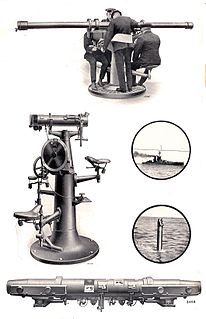 W
WBarr & Stroud Limited was a pioneering Glasgow optical engineering firm. They played a leading role in the development of modern optics, including rangefinders, for the Royal Navy and for other branches of British Armed Forces during the 20th century. There was a non-military arm of the company which made medical equipment, like photocoagulators and electronic filters, some of which were used by the BBC. The company and its intellectual property passed through Pilkington group to Thales Optronics. The Barr and Stroud name was sold on to an importer of optical equipment who use the trademarked name for a line of binoculars and similar instruments.
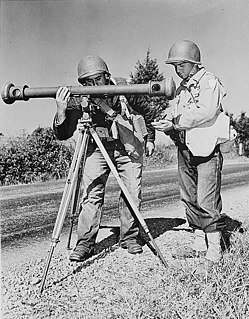 W
WA coincidence rangefinder or coincidence telemeter is a type of rangefinder that uses mechanical and optical principles to allow an operator to determine the distance to a visible object. There are subtypes split-image telemeter, inverted image, or double-image telemeter with different principles how two images in a single ocular are compared. Coincidence rangefinders were important elements of fire control systems for long-range naval guns and land-based coastal artillery circa 1890–1960. They were also used in rangefinder cameras.
 W
WColossus was a set of computers developed by British codebreakers in the years 1943–1945 to help in the cryptanalysis of the Lorenz cipher. Colossus used thermionic valves to perform Boolean and counting operations. Colossus is thus regarded as the world's first programmable, electronic, digital computer, although it was programmed by switches and plugs and not by a stored program.
 W
WThe Cora was a digital fire-control system designed by Peter Toth and produced by the Swiss company Contraves.
 W
WThe D37D Minuteman III flight computer was initially supplied with the LGM-30G missile, as part of the NS-20 navigation system. The NS-20 D37D flight computer is a miniaturized general purpose digital computer. The new NS-50 missile guidance computer (MGC) is built around a 16-bit high-speed microprocessor chip set. They are both designed to solve real-time positional error problems under the adverse conditions encountered in airborne weapon systems. They accept and process data and generate steering signals with sufficient accuracy and speed to meet the requirements of the inertial guidance and flight control systems of the Minuteman ICBMs.
 W
WDATAR, short for Digital Automated Tracking and Resolving, was a pioneering computerized battlefield information system. DATAR combined the data from all of the sensors in a naval task force into a single "overall view" that was then transmitted back to all of the ships and displayed on plan-position indicators similar to radar displays. Commanders could then see information from everywhere, not just their own ship's sensors.
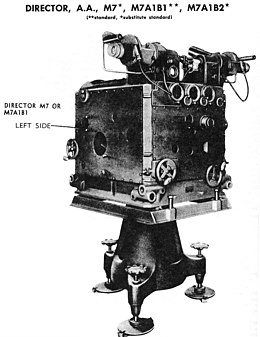 W
WA director, also called an auxiliary predictor, is a mechanical or electronic computer that continuously calculates trigonometric firing solutions for use against a moving target, and transmits targeting data to direct the weapon firing crew.
 W
WThe Distributed Common Ground System (DCGS) is a system which produces military intelligence for multiple military branches.
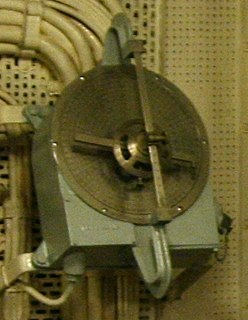 W
WThe Dumaresq is a mechanical calculating device invented around 1902 by Lieutenant John Dumaresq of the Royal Navy. It is an analogue computer that relates vital variables of the fire control problem to the movement of one's own ship and that of a target ship.
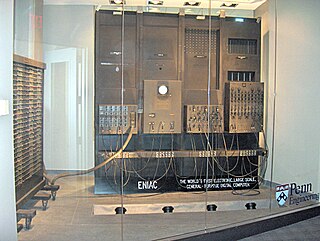 W
WENIAC was the first programmable, electronic, general-purpose digital computer. It was Turing-complete, and able to solve "a large class of numerical problems" through reprogramming.
 W
WA fire-control system is a number of components working together, usually a gun data computer, a director, and radar, which is designed to assist a ranged weapon system in targeting, tracking and hitting its target. It performs the same task as a human gunner firing a weapon, but attempts to do so faster and more accurately.
 W
WThe Fuze Keeping Clock (FKC) was a simplified version of the Royal Navy's High Angle Control System analogue fire control computer. It first appeared as the FKC MkII in destroyers of the 1938 Tribal class, while later variants were used on sloops, frigates, destroyers, aircraft carriers and several cruisers. The FKC MkII was a non-tachymetric anti-aircraft fire control computer. It could accurately engage targets with a maximum speed of 250 knots.
 W
WHigh Angle Control System (HACS) was a British anti-aircraft fire-control system employed by the Royal Navy from 1931 onwards and used widely during World War II. HACS calculated the necessary deflection required to place an explosive shell in the location of a target flying at a known height, bearing and speed.
 W
WThe IBM System/4 Pi is a family of avionics computers used, in various versions, on the F-15 Eagle fighter, E-3 Sentry AWACS, Harpoon Missile, NASA's Skylab, MOL, and the Space Shuttle, as well as other aircraft. The name of the system refers to the number of steradians (4π) in a sphere. Development began in 1965, deliveries in 1967.
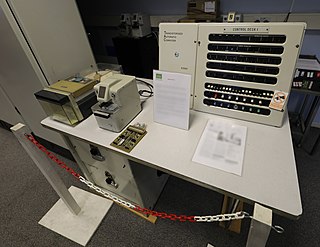 W
WThe Marconi Transistorized Automatic Computer was the first computer built by Britain's Marconi Company. It was designed and manufactured from around 1959.
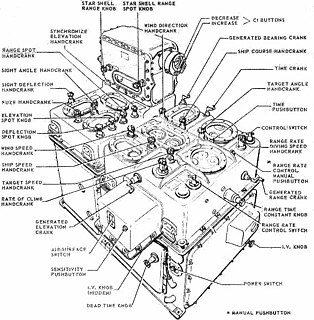 W
WThe Mark 1, and later the Mark 1A, Fire Control Computer was a component of the Mark 37 Gun Fire Control System deployed by the United States Navy during World War II and up to 1969 or later. It was developed by Hannibal Ford of the Ford Instrument Company. It was used on a variety of ships, ranging from destroyers to battleships. The Mark 37 system used tachymetric target motion prediction to compute a fire control solution. Weighing more than 3,000 pounds (1,400 kg), the Mark 1 itself was installed in the plotting room, a watertight compartment that was located deep inside the ship's hull to provide as much protection against battle damage as possible.
 W
WThe 3″/50 caliber gun in United States naval gun terminology indicates the gun fired a projectile 3 inches (76 mm) in diameter, and the barrel was 50 calibers long. Different guns of this caliber were used by the U.S. Navy and U.S. Coast Guard from 1890 through the 1990s on a variety of combatant and transport ship classes.
 W
WSylvania's MOBIDIC, short for "MOBIle DIgital Computer", was a transistorized computer intended to store, sort and route information as one part of the United States Army's Fieldata concept. Fieldata aimed to automate the distribution of battlefield data in any form, ensuring the delivery of reports to the proper recipients regardless of the physical form they were sent or received. MOBIDIC was mounted in the trailer of a semi-trailer truck, while a second supplied power, allowing it to be moved about the battlefield. The Army referred to the system as the AN/MYK-1, or AN/MYK-2 for the dual-CPU version, Sylvania later offered a commercial version of the S 9400.
 W
WNaval Tactical Data System (NTDS) was a computerized information processing system developed by the United States Navy in the 1950s and first deployed in the early 1960s for use in combat ships. It took reports from multiple sensors on different ships and collated it to produce a single unified map of the battlespace. This information could then be relayed back to the ships and to the weapons operators.
 W
WThe Norden Mk. XV, known as the Norden M series in U.S. Army service, is a bombsight that was used by the United States Army Air Forces (USAAF) and the United States Navy during World War II, and the United States Air Force in the Korean and the Vietnam Wars. It was an early tachometric design that directly measured the aircraft's ground speed and direction, which older bombsights could only estimate with lengthy manual procedures. The Norden further improved on older designs by using an analog computer that continuously recalculated the bomb's impact point based on changing flight conditions, and an autopilot that reacted quickly and accurately to changes in the wind or other effects.
 W
WA combat information center (CIC) or action information centre (AIC) is a room in a warship or AWACS aircraft that functions as a tactical center and provides processed information for command and control of the near battlespace or area of operations. Within other military commands, rooms serving similar functions are known as command centers.
 W
WPilkington is a Japanese-owned glass-manufacturing company which is based in Lathom, Lancashire, United Kingdom. In the UK it includes several legal entities and is a subsidiary of Japanese company NSG Group.
 W
W"Pom-Pom" director was a director for British anti-aircraft guns on British warships of the 1930s into the Second World War.
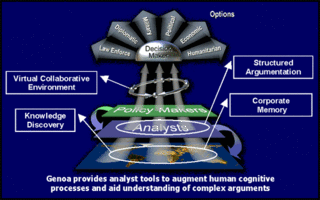 W
WProject Genoa was a software project commissioned by the United States' DARPA which was designed to analyze large amounts of data and metadata to help human analysts counter terrorism.
 W
WProject Genoa II was a software project that originated with the United States Defense Advanced Research Projects Agency's Information Awareness Office and the successor to the Genoa program. Originally part of DARPA's wider Total Information Awareness project, it was later renamed Topsail and handed over to the Advanced Research and Development Activity for further development.
 W
WRangekeepers were electromechanical fire control computers used primarily during the early part of the 20th century. They were sophisticated analog computers whose development reached its zenith following World War II, specifically the Computer Mk 47 in the Mk 68 Gun Fire Control system. During World War II, rangekeepers directed gunfire on land, sea, and in the air. While rangekeepers were widely deployed, the most sophisticated rangekeepers were mounted on warships to direct the fire of long-range guns.
 W
WThe NATO Army Armaments Group (NAAG) Integrated Capability Group Indirect Fires (ICGIF), formerly Land Group 4, and their Sub Group 2 (SG2) on Surface to Surface Ballistics has created a widely used set of shareable fire control software using the Ada programming language. This product is known as the SG2 Shareable (Fire Control) Software Suite (S4) and is sometimes abbreviated as S4 when referenced.
 W
WShip gun fire-control systems (GFCS) are analogue fire-control systems that were used aboard naval warships prior to modern electronic computerized systems, to control targeting of guns against surface ships, aircraft, and shore targets, with either optical or radar sighting. Most US ships that are destroyers or larger employed gun fire-control systems for 5-inch (127 mm) and larger guns, up to battleships, such as Iowa class.
 W
WThe Tartar Guided Missile Fire Control System is an air defense system developed by the United States Navy to defend warships from air attack. Since its introduction the system has been improved and sold to several United States allies.
 W
WThe Torpedo Data Computer (TDC) was an early electromechanical analog computer used for torpedo fire-control on American submarines during World War II. Britain, Germany, and Japan also developed automated torpedo fire control equipment, but none were as advanced as the US Navy's TDC, as it was able to automatically track the target rather than simply offering an instantaneous firing solution. This unique capability of the TDC set the standard for submarine torpedo fire control during World War II.
 W
WThe TRADIC was the first transistorized computer in the USA, completed in 1954.
 W
WThe ERA 1101, later renamed UNIVAC 1101, was a computer system designed and built by Engineering Research Associates (ERA) in the early 1950s and continued to be sold by the Remington Rand corporation after that company later purchased ERA. Its (initial) military model, the ERA Atlas, was the first stored-program computer that was moved from its site of manufacture and successfully installed at a distant site. Remington Rand used the 1101's architecture as the basis for a series of machines into the 1960s.
 W
WThe UNIVAC 1102 or ERA 1102 was designed by Engineering Research Associates for the United States Air Force's Arnold Engineering Development Center in Tullahoma, Tennessee in response to a request for proposal issued in 1950. The Air Force needed three computers to do data reduction for two wind tunnels and an engine test facility.
 W
WThe UNIVAC 1103 or ERA 1103, a successor to the UNIVAC 1101, was a computer system designed by Engineering Research Associates and built by the Remington Rand corporation in October 1953. It was the first computer for which Seymour Cray was credited with design work.
 W
WThe Vickers Range Clock was a clockwork device used by the Royal Navy for continuously calculating the range to an enemy ship.